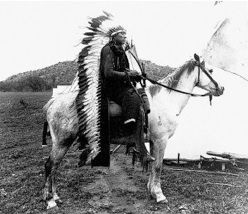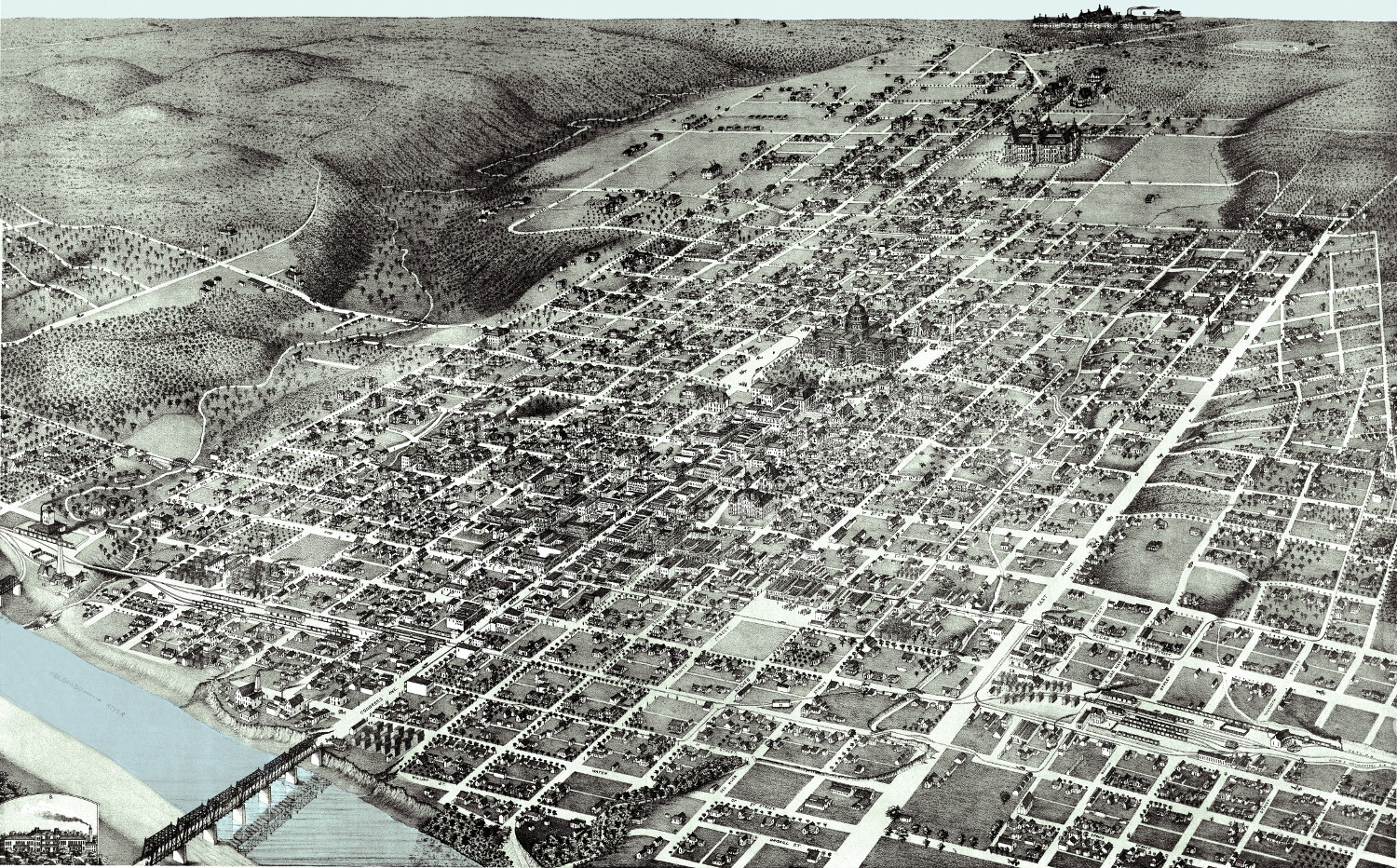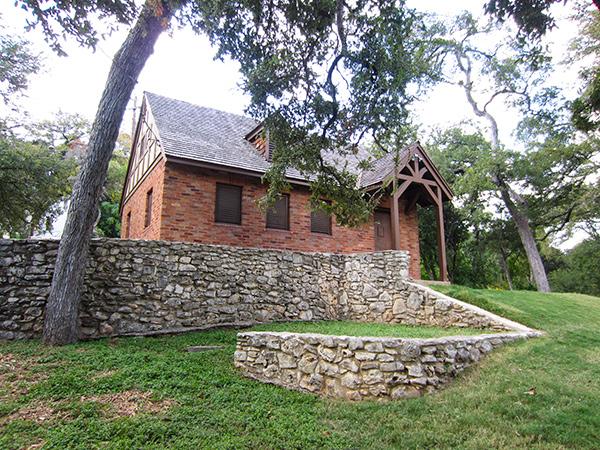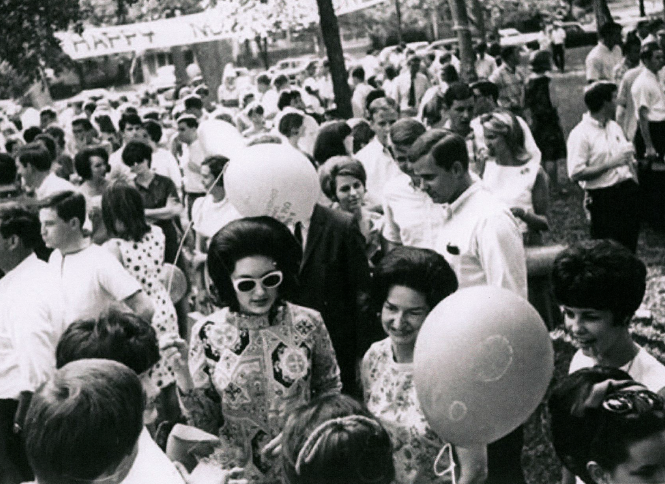As one of Texas’ first public parks, Pease Park has a rich and storied history. From native civilizations evidenced as early as 11,400 years ago, to Edwin Waller's city map in 1839, to Governor Pease's donation of land in 1875, to Janet Fish constructing the nation's first hike-and-bike trail - Pease Park is an integral civic landmark in modern Austin.
Native Americans
Archaeologists have determined that the earliest ancestors of the Native Americans were in Central Texas 11,400 years ago. This was a time when the drought was ending and the great glaciers were retreating back across Canada. The Central Texas area was becoming green, and some of the now extinct ice age animals like giant bison were still here. Native American tribes wintered in Texas and in the summer followed the bison herds across the Great Plains.
After they were forced out of the Great Plains, the Lipan Apache, Tonkawa, and Comanche tribes lived in Texas, including Central Texas. When Spanish and American colonizers began to arrive in the 1800s, these Native American populations suffered substantial losses due to diseases and conflicts over land and natural resources brought by these groups.
When Texas became independent from Mexico in 1836, Anglo colonizers began to arrive in droves. Even more land was stolen from the Native people in the region and conflicts continued to escalate after Texas became a part of the United States. The majority of the Native American tribes in the area were ultimately forced by the US Government to move to reservations in present-day Oklahoma.
After decades of battles in an effort to defend their land, the Comanche people were led by Chief Quanah Parker to a reservation in Oklahoma. The Tonkawa were removed from Texas and transported by railroad to Oklahoma where they completed the Tonkawa “Trail of Tears” in 1885.
We acknowledge that the land on which Pease Park sits was once home to the Lipan Apache, Tonkawa, and Comanche Nations. It is our intention to share this history with park-goers and to make Pease Park a place that honors the lives and struggles of the Native people who once lived here. We ask that you take a moment to honor these ancestral grounds and celebrate the resilience and strength that all indigenous people have shown worldwide.
Shallow Waters
Shoal Creek was given its name by Edwin Waller, who used it as the western boundary of Austin while laying out the original town-site (called Waterloo) in 1839. A shoal is a place in any body of water where the water is especially shallow. This nine-mile intermittent stream is fed by natural underground springs and carries rainwater south to the Colorado River, emptying into Lady Bird Lake.
Becoming Pease Park
The site of today’s Pease District Park was part of the 365-acre Woodlawn Plantation owned by former Texas Governor & Mrs. E.M. Pease. Their 1853 house of the same name still sits a mere two blocks west of the park’s boundary today. Governor Pease and his wife acquired it in 1857 and raised crops for their family on this property.
Originally from Enfield, Connecticut, the twenty-three year old Pease moved to Texas in 1835. He was an attorney and soon became active in the Texas Independence movement. He held several offices in the new Republic of Texas government, including serving as Texas Comptroller. After Texas was annexed to the Union in 1845, he served in both the House and Senate of the Texas Legislature, representing Brazoria and Galveston counties. Pease went on to be elected Governor in 1853 and 1855. He is remembered both as a progressive, the father of Texas public education who laid the financial foundation for the state’s schools and colleges, and as a fiscal conservative who paid off the state’s debts.
Pease was a slave owner who strongly supported the Union cause during the American Civil War. He and his wife remained in Austin for the duration of the conflict and kept a low profile in civic affairs. After the war, he became a leader of the state Republican Party. Union General Philip H. Sheridan appointed Pease as the civilian Governor of Texas during Reconstruction in 1867. Pease tried to steer a middle course between the more radical policies of some Republicans and his unreconstructed ex-Confederate fellow Texans. This proved an impossible task given the heated temperament of the times and he resigned in 1869.
After leaving politics, he and his wife Lucadia looked to their legacy in their adopted state. Mrs. Pease had always enjoyed carriage rides along the banks of the Shoal Creek below their plantation house. She regarded it as the “prettiest part” of their property. The Pease family traveled back to the East frequently to visit relatives and were certainly aware of the development of Central Park in New York City and Prospect Park in Brooklyn, designed by fellow Connecticut-born Frederick Law Olmsted. Public parks were being developed in cities all across the country after the Civil War as part of the nascent “City Beautiful” movement and the Pease’s wanted their adopted home of Austin to keep up with the times.
On August 25, 1875, Governor & Mrs. Pease signed a deed to 23 acres of land along Shoal Creek to the citizens of Austin “for use as a public park.” However, improvements to the space were not immediately forthcoming. Governor Pease died in 1883 without seeing his dream of a developed park become a reality. Lucadia wrote a letter recounting that the family had opened a road through their pasture to the city but it has become a dumping ground for neighbors. She wrote “… dead horses, cows and pigs are brought and deposited there.”
Lucadia Pease lived on Woodlawn until 1905, long enough to see the park fully appreciated and used by Austin residents. She and her daughter Julia attended the annual Volunteer Fireman’s picnic in the park on San Jacinto Day, April 21, 1903. A.P. Wooldridge, who later became Austin’s mayor, gave a speech on the occasion extolling the Pease’s generous gift in the long-winded fashion typical of the time. His prepared remarks were reported in the Austin Statesman:
“How grateful should our people be the noble founder of the park. In giving this spot, Governor Pease thought alone of their contentment and pleasure and happiness. He loved Austin and her people and took great pride in her beauty and progress…He had great faith in Austin… [I]s it not a duty for the health and happiness of our people that we should provide ample and appropriate places for their recreation and leisure?” He summed up by calling on the City to “… forever maintain a large and beautiful park [at Pease] for the health and happiness of our people.”
In 1926, the Austin Kiwanis Club committed to beautifying Pease Park. Club member Frank Rundell, who lived on Wooldridge Drive for many years, served as general contractor for the project. According to the Austin Statesman, $4,500 was appropriated for a restroom, $1,000 for the memorial entrance gates, $1,200 for the wading pool, and $1,600 for a low water dam.
After its 1926 beautification, Pease Park thrived with parties, concerts, Easter Egg Hunts, and many other public and private functions.
The Tudor Cottage
The old restroom, known as the Tudor Cottage, is widely believed to have been designed by noted architecture firm Giesecke & Harris. The Cottage is one of the earliest buildings constructed in Austin as a park facility. The restrooms were designed in the mid-1920s. Giesecke & Harris designed the Austin High School Annex and Lee Elementary, as well as the Merchants and Manufacturers Building in Houston.
The 24th Street Bridge
The bridge was built in July 1928 in only 28 days to bring potential buyers across Shoal Creek to new neighborhoods. It incorporates a difficult decorative concrete technique and was declared one of the most beautiful bridges in Texas. In 1939, the bridge was widened to four lanes and was a Works Progress Administration (WPA) project stemming from the Great Depression. In 1988, the city planned to demolish the bridge to widen Windsor Road to six lanes, but many citizens, including Senator Ralph Yarborough, lobbied to preserve the bridge and it was given protected historic landmark status that year.
The Philanthropists
In 1952, Janet Long Fish, daughter of Austin community leader, Walter E. Long, had the idea that a walkthrough path along the roadbed of the old Comanche trail would help preserve the disappearing road, which ran from the shoal of the Colorado river up along Shoal Creek to 34th Street where it crossed the creek and continued west and north into the hills.
She persuaded the Austin City Council to approve the construction of the hike and bike trail from Pease Park to 39th street, spending her own money, time and effort in getting it done.
For four years, Fish led a bulldozer along the trail to grade it according to the City requirements. One day she disappeared into the six foot high ragweed. From then on, she threw her hat into the air every few steps so that the bulldozer driver could follow her.
Since 1961, the City of Austin has maintained and patrolled the trail. Many other individuals, serving as volunteers for community service organizations including the Junior League of Austin and the Austin Metro Trails and Greenways, have contributed time, effort and money towards the preservation of Shoal Creek.
Eeyore’s Birthday Party
Eeyore’s Birthday Party, started in 1963 as a spring party for Department of English students at the University of Texas, has been hosted at Pease Park since the 1970s. The event was named for Eeyore, the chronically depressed donkey in A.A. Milne's "Winnie the Pooh" stories. Eeyore believes his friends have forgotten his birthday only to discover they have planned a special celebration for him.
The party became a much-loved Austin tradition. The Birthday Party occurs annually on the last Saturday in April.






